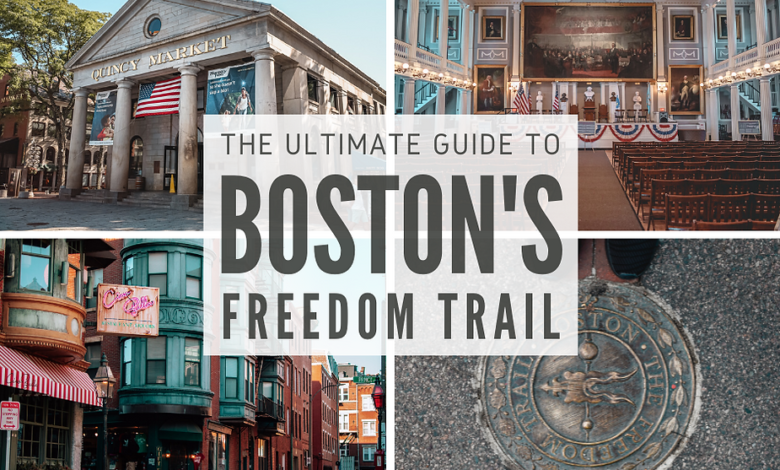Boston’s Freedom Trail: A Historical and Cultural Journey

Boston’s Freedom Trail is a trail that winds its way through some of the most significant historical landmarks in the city, highlighting the important role Boston played in shaping the American Revolution. The trail was established in 1958 by a group of informed citizens who wanted to preserve and showcase the city’s rich cultural and historical heritage.
The trail begins at the Boston Common and ends at the Bunker Hill Monument in Charlestown. The Freedom Trail passes by 16 significant historical sites that date back to the Revolutionary War era. These sites include the Massachusetts State House, Park Street Church, the Old South Meeting House, the Paul Revere House, the Old North Church, and the USS Constitution Museum, among others.
Each of these sites provides a unique glimpse into Boston’s rich history, culture, and architecture. Visitors can walk down the cobblestone streets, explore centuries-old church buildings, or marvel at the remarkable craftsmanship of 18th-century architecture.
The Freedom Trail provides an immersive and engaging experience for both visitors and locals alike. To plan your day along the trail, visitors can choose to go on a guided tour or explore at their leisure. Additionally, the Freedom Trail Foundation regularly offers free guided walking tours that are led by engaging and knowledgeable tour guides.
In other words, the Freedom Trail is a historical and cultural journey that is a must-visit for anyone interested in American history. It provides a unique opportunity to learn about American history and explore some of the most iconic landmarks in Boston.
The History of the Freedom Trail
The Freedom Trail is a historical trail that was established in 1951 to showcase Boston’s rich history and culture. It was created by a group of informed citizens who wanted to preserve Boston’s revolutionary past, and it remains one of the most popular tourist attractions in the city today. The trail connects 16 historical sites, including churches, burial, museums, and meeting houses, covering a distance of 2.5 miles throughout downtown Boston. Visitors to the Freedom Trail can walk down cobblestone streets and explore centuries-old buildings, gain insight into the American Revolution, and learn about the significant role Boston played in shaping American history.
The Freedom Trail provides an opportunity to learn about influential figures and landmarks of the revolutionary era, such as the Paul Revere House, Old North Church, and the USS Constitution Museum, among others. Visitors can choose to walk the trail at their leisure or choose one of several guided tours that provide historical insight while maintaining a fun and engaging atmosphere. The Freedom Trail is a significant part of Boston’s history and culture and is an excellent opportunity for history buffs, families, and tourists to experience the impact Boston has had on American history.
The Sites Along the Trail
The Freedom Trail is a 2.5-mile-long path that passes through 16 historical sites in Boston, Massachusetts. The trail serves as a walk through America’s history and features some of the country’s most significant landmarks. Each of the sites along the trail has a unique story to tell, and visitors get to experience a piece of America’s past by visiting them.
Some of the most popular sites found on the Freedom Trail include the Massachusetts State House, the oldest building on Beacon Hill constructed in 1798, and famous for being the seat of the state government. Also included is the Paul Revere House, which was built in 1680. The oldest building in downtown Boston and the home of Paul Revere, a famous patriot who warned of the British invasion. The Old North Church is another famous site on the trail, built-in 1723 and considered the oldest standing church in Boston. It was at this church that Paul Revere hung his famous lanterns to signal the British invasion. Lastly, the Bunker Hill Monument is an essential site along the trail that commemorates the Battle of Bunker Hill, one of the first major battles of the American Revolution. Built-in 1843, visitors can climb the 294-step staircase to the top and gaze upon a breathtaking view of the city.
If you’re planning to stay near the Freedom Trail, the trail spans through three distinct areas of Boston, including Beacon Hill/Historic Downtown, the North End, and Charlestown. The trail connects nationally significant landmarks, and its significance to America’s history makes it a must-visit for tourists.
Planning Your Visit
To plan your visit to the Freedom Trail, the first step is to download the official online brochure that provides a map of the trail and information about each of the 16 historical sites. Using this guide will help in following the path that leads to iconic sites like Massachusetts State House, Paul Revere House, Old North Church, and Bunker Hill Monument, among others.
The Freedom Trail Foundation also offers guided walking of the trail, which are highly recommended to those interested in learning in-depth information about the history of Boston and the sites along the trail. Knowledgeable guides lead the 90-minute walking tours, and tickets for the tours can be purchased online or at the Boston Common Visitor Information Center.
For those who prefer to explore on their own, many of the historical sites have docents and exhibits that provide in-depth information about the rich history of Boston. Tourists can use different resources walk the Freedom Trail at their pace, like a map, brochure, guidebook, audio guide, smartphone app or kid’s guide.
There are no specific guidelines for completing the Freedom Trail, but the time spent on each site can vary depending on individual preference and schedule. The trail route is based on geographical locations and is not in chronological order, so it is essential to rely on a guide or map to locate each site. Boston’s Freedom trail is an excellent opportunity to learn about America’s rich history, and tourists should make the most of their visit by planning and exploring its various sites.
Boston’s Freedom Trail, measuring 2.5 miles, passes through 16 historical sites that offer a captivating glimpse into Boston’s revolutionary past. The Freedom Trail is a must-see attraction for anyone interested in American history and culture, featuring some of America’s most monumental landmarks. Boston Common, the oldest public park established in 1634, is the starting point of the trail, and visitors can download the official trail brochure for a comprehensive guide of the 16 sites on the trail.
Tourists can either explore the 16 historical sites solo, where each site has docents to provide in-depth information about Boston’s rich history, or take a guided tour. The Freedom Trail Foundation offers guided walking tours led by knowledgeable guides, with tickets for the tours purchasable at the Boston Common Visitor Information Center. Tourists can also plan their trail by using a map, brochure, guidebook, audio guide, smartphone app, or a kid’s guide to walk the Freedom Trail at their own pace.
In conclusion, visitors exploring Boston’s Freedom Trail will reach significant historical sites such as Massachusetts State House, Paul Revere House, Old North Church, and Bunker Hill Monument, among others. The trail’s historical significance makes it imperative for tourists to plan their visit to experience a unique glimpse into America’s past by either going solo or taking a guided tour. Overall, a visit to the Freedom Trail is an extraordinary and unforgettable experience.



